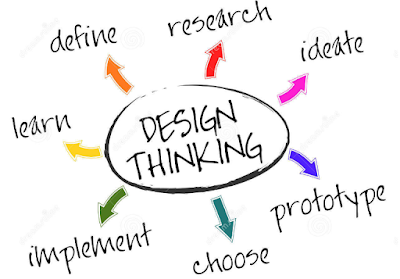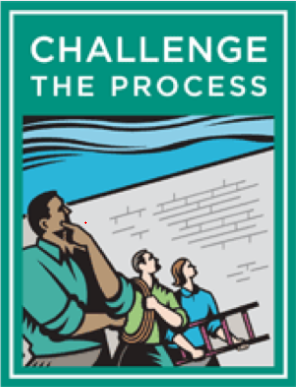The act of
challenging evokes images of a duel, an impending fight, or opponents up in
arms; however, 'challenging' as a descriptive word brings to mind words like
demanding, difficult, and requiring effort.
So what would
'challenging a process' encompass? According to Kouzes & Posner, to
challenge the process "you search for opportunities by seeking innovative
ways to change, grow, and improve, and you experiment and take risks by
constantly generating small wins and learning from mistakes."
 |
| Image source: http://lollypop.biz/media/1929/12d65a162c9f74809ba4205dda62c55a.jpg |
 |
| Image source: http://inchoo.net/wp-content/uploads/2016/06/design-thinking-3.png |
These two
websites provide the history or design thinking: Website_1 and Website_2. When we think of design, we automatically co-relate it
with aesthetics; however Tim Brown, the guru of Design Thinking defines
it as "...a discipline that uses the
designer’s sensibility and methods to match people’s needs with what is
technologically feasible and what a viable business strategy can convert into
customer value and market opportunity." (https://designthinking.ideo.com/?p=49). However, he questions if there is a general definition of Design Thinking and whether it is useful to have one. This concept now has a wide variety of application besides just in the technological field.
 |
| Image source: https://thumbs.dreamstime.com/z/design-thinking-23211111.jpg |
As the two websites about the history of Design Thinking suggest, it began as a method or a tool, but is now come to be a mindset. In his HBR
article titled Design Thinking Comes of Age, Jon Kolko, VP of design at
Blackboard; founder and director of Austin Center for Design; and the author of
Well-Designed: How to Use Empathy to Create Products People Love (HBR Press,
2014) refers to Design Thinking as "applying the principles of design to
the way people work" and identifies these principles as "empathy with
users, a discipline of prototyping, and tolerance for failure (as) chief among
them". He takes this a step further to having a "design-centric culture".
I think at
this point, my organization would most benefit from having a design-centric
culture. Using the evolution of design thinking explained in this blog cited
earlier, my organization is probably doing the rounds between Participatory
Design and User-Centered Design, maybe sometimes Service Design; but where we
need to get to is Human Centered Design.
 |
| Very Brief Summary of the Evolution of Design Thinking (Ref Blog: I Think Therefore I Design) |
This
transition is important given the changes that are taking place in
organizations today (our client organizations), especially in the field of
learning. Social learning is playing a big part in helping employees learn
informally; employees are leveraging instant messaging to gain information and
are surfing the internet as well for quick "how to" videos. Content
curation is rising and will continue to do so, thereby increasing the need for
creating learning solutions in collaboration with the users. The speed at which
things change is so quick that there is hardly time to go through the normal
development cycle to create solutions/products; stakeholders demand quick
iterations which they can review and provide feedback on, so Agile is the need
of the hour. What's more important that design thinking needs be a
"culture" and not a department in the organization because all
employees in my organization are involved in bringing the solution to life.
Implementing
this innovation is sure to bring about disruption in the organization and its
way of functioning but it will certainly help handle market uncertainty and
complexity much better. Here, the design principle of tolerating failure (from
Jon Kolko's article) will of utmost importance to the organization . As noted
by Jon "a design culture is nurturing. It doesn’t encourage failure, but
the iterative nature of the design process recognizes that it’s rare to get
things right the first time."
My organization will probably have to
remind itself of this principle once it is on the path of adopting Design
Thinking. This also goes back Kouzes & Posner's point about challenging the process being all about taking risks and learning from mistakes.
Disclaimer: All images have been taken from google images and are used for educational purposes only.


No comments:
Post a Comment